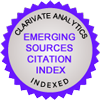Ar-Ge proje seçim problemine yeni bir yaklaşım ve çözüm önerisi: UTA yöntemi
Ela Binici1, Erdem Aksakal21Erzurum Teknik Üniversitesi,proje Uygulama Ve Araştırma Merkezi,Erzurum2Atatürk Üniversitesi,mühendislik Fakültesi,endüstri Mühendisliği Ana Bilim Dalı,Erzurum
Küreselleşmenin hızla arttığı günümüzde rekabet edebilirliğin temeli bilgiye dayanmaktadır. Bilgi, Ar-Ge çalışmaları ile sistematik hale getirilerek bilim ve teknolojiye dönüşür. Bir ülkenin kalkınması katma değer üretmesi, istihdam sağlayabilmesi, üretimlerini sürekli artırarak devam ettirebilmesi ancak bilgi birikiminin artması ve artan bilginin bilim ve teknolojiye dönüştürülmesi ile mümkündür. Ürün ve hizmet çeşitliliğinin çok fazla olduğu göz önüne alındığında ülkelerin ve üreticilerin bu faaliyetlerini sürdürebilmeleri ve rekabet edebilmeleri için yenilikler ortaya koyması gerekmektedir. Bu konuda araştırma ve geliştirme (Ar-Ge) büyük önem taşımaktadır. Ar-Ge, hali hazırda bulunan bilgilerden yeni ürün, yeni üretim yöntemlerinin geliştirilmesi veya yeni teknolojilerin, ürünlerin, üretim yöntemlerinin elde edilmesi olarak tanımlanabilir. Diğer ülkelerde olduğu gibi ülkemiz de Ar-Ge yatırımlarını teşvik etmekte ve Ar-Ge yatırımlarına destek vermektedir. Bu kapsamda birçok kurum ve kuruluş girişimcilerin, firmaların, akademisyenlerin Ar-Ge projelerini sağladığı katma değer oranında desteklemektedir. Ar-ge boyutunda desteğin belirlenmesinde etkin olacak katma değer ise fayda olarak değerlendirilebilir. Bu amaçla desteklerin etkin bir şekilde kullanılması göz önüne alınarak, çalışmamızda Ar-Ge projelerinin seçiminin yapıldığı bir yarışmada projelerin değerlendirme süreci ele alınmıştır. UTA yöntemi marjinal faydayı dikkate alan yapısı ve doğrusal programlama yaklaşımını içermesi nedeniyle tercih edilmiştir. Yöntemin çözüm aşamasında elde edilen matematiksel modelin çözümü için de GAMS Programından yararlanılmıştır. Bulunan çözümün fayda temelli olmasından dolayı projelerin daha etkin ve doğru şekilde sıralanmasına destek sağlayabileceği gösterilmeye çalışılmıştır.
Anahtar Kelimeler: UTA Yöntemi, Ar-Ge Proje Seçimi, Çok Kriterli Karar Verme Yöntemi.A new approach to R&D project selection problem and a solution proposal: UTA method
Ela Binici1, Erdem Aksakal21Project Coordination Implementation and Research Center, Erzurum Technical University, Erzurum, Turkey2Department of industrial engineering,Atatürk University,Erzurum,Turkey
Nowadays with the rapid increase in globalization, competitiveness is based on the information. Information is transformed into science and technology by systematizing with research and development studies. The development of a country, producing added value, providing employment, continuing to increase in production continuously is only possible by increasing the information content and by converting the increasing information into science and technology. Considering the variety of products and services is very much, innovation is necessary for countries and producers for to continue and compete in the activities. In this regard, research and development (R&D) carries great importance. R&D can be defined as the development of new products, new production methods, or the acquisition of new technologies, products, production methods from present information. As it is in other countries, our country also encourages R&D investments and supports R & D investments. In determining the size of support according to the R&D dimension, the value added which will be effective can be evaluated as benefit. For this purpose, in our study, the projects were ranked in a competition where R & D projects are selected by considering the efficient use of supports. In this sense, the UTA Method which is one of Multi-Criteria Decision Making (MCDM) methods was preferred for the solution process for our problem. UTA method preferred because of its considering marginal utility structure and linear programming approach. The GAMS program was used to solve the mathematical model obtained during the solution process. Because of being benefit-based, ıt has been tried to be shown that the solution can support the ranking of projects more effectively and correctly.
Keywords: UTA Method, Selection of R&D Project, Multi Criteria Decision MethodMakale Dili: Türkçe





